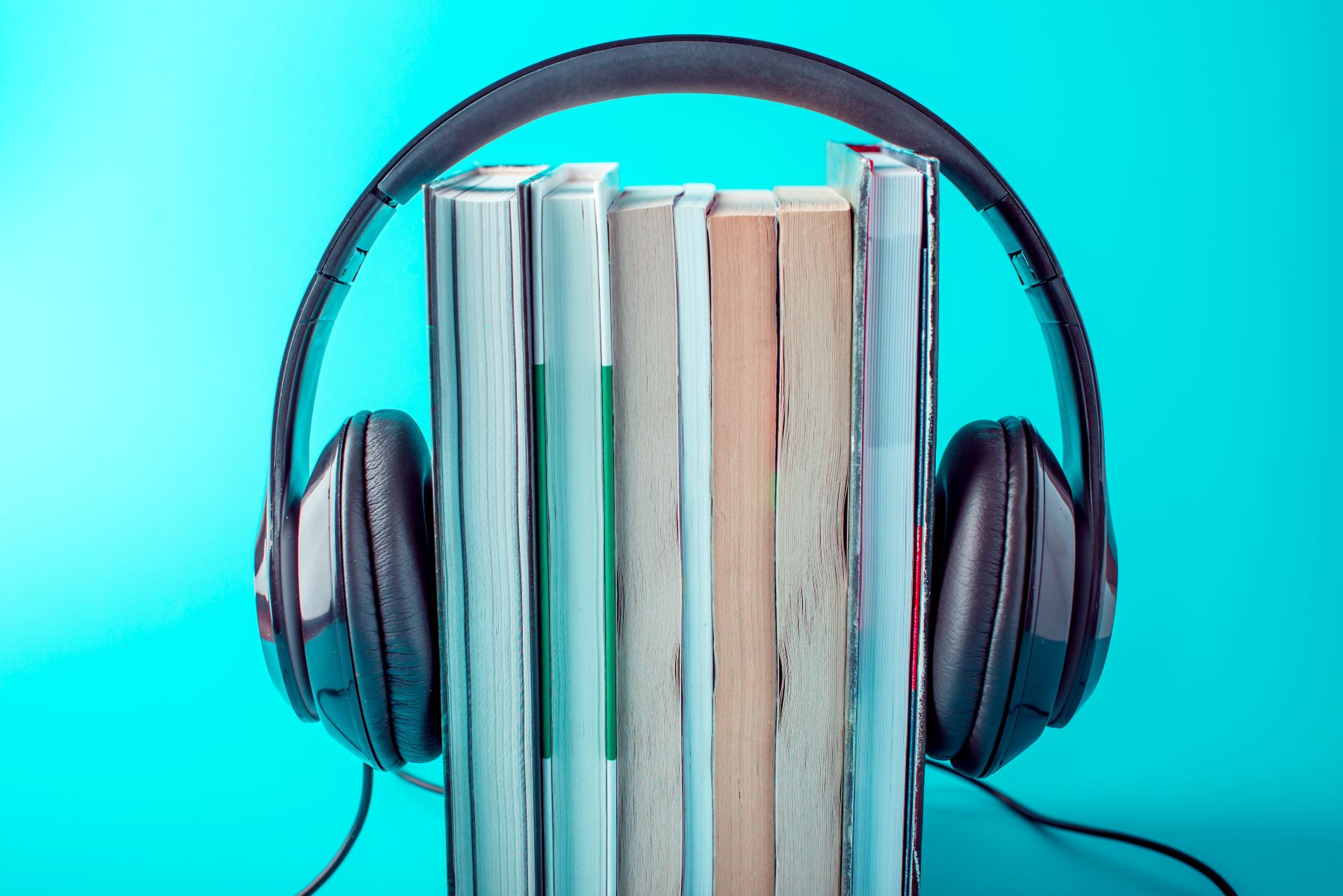Home>Production & Technology>Audiobook>How Does Audiobook Work


Audiobook
How Does Audiobook Work
Modified: January 22, 2024
Discover how audiobooks work and enhance your reading experience with this comprehensive guide on audiobooks. Explore the benefits and find out how to get started.
(Many of the links in this article redirect to a specific reviewed product. Your purchase of these products through affiliate links helps to generate commission for AudioLover.com, at no extra cost. Learn more)
Table of Contents
Introduction
Welcome to the fascinating world of audiobooks! In this digital age, where technology is constantly evolving, the way we consume literature is also undergoing a transformation. Audiobooks have gained immense popularity, offering a convenient and immersive alternative to traditional printed books. Whether you’re a book-lover with a hectic schedule or someone who prefers multitasking, audiobooks provide a unique and enjoyable experience.
An audiobook, also known as a talking book, is a recorded version of a book that is narrated by a professional voice actor or the author themselves. These audio recordings allow listeners to enjoy a literary work by simply listening to it, without the need for physically reading the text. With the rise of smartphones and digital platforms, audiobooks have become easily accessible, revolutionizing the way we engage with literature.
Throughout history, storytelling has always played a vital role in human culture. From ancient oral traditions to the invention of the printing press, the desire to share stories and knowledge has persisted. The advent of technology has further expanded the options for storytelling, making audiobooks a popular choice for both authors and readers.
The components of an audiobook are what make it a unique and engaging medium. The narration brings the story to life, as the voice actor captures the nuances of the characters and the emotions of the narrative. Sound effects and background music may also be added to enhance the overall listening experience.
Audiobooks come in various formats, catering to different preferences and devices. Physical audiobooks are available in CDs or cassette tapes, while digital formats are becoming increasingly popular. Digital audiobooks can be downloaded or streamed from online platforms, making it convenient for listeners to access their favorite titles anytime, anywhere.
The production process of an audiobook involves several stages. First, the book is carefully selected, and a narrator is chosen to bring the story to life. The recording takes place in a professional studio, where the narrator reads the book in a clear and expressive manner. The audio is then edited and mixed to ensure a seamless listening experience. Finally, the finished audiobook is released to the public through various distribution channels.
The benefits of audiobooks are numerous. They provide a solution for individuals with visual impairments or reading difficulties, enabling them to enjoy books in a different format. Moreover, audiobooks allow for multitasking, allowing listeners to engage in other activities while still enjoying a good story. For those on long commutes or frequent travelers, audiobooks offer a perfect companion, turning mundane journeys into captivating adventures.
In the following sections, we will delve deeper into the history of audiobooks, explore the various formats available, and discuss the accessibility and advantages of this increasingly popular literary medium. So grab your headphones, sit back, and immerse yourself in the world of audiobooks.
Definition of Audiobook
An audiobook is a form of literature that is presented in an audio format, allowing for an immersive and convenient listening experience. It is an alternative to traditional print books, offering a unique way to consume literature. In an audiobook, the text of a book is narrated by a professional voice actor or even the author themselves, bringing the story to life through spoken words.
Unlike printed books, audiobooks do not require the physical act of reading. Instead, they rely on auditory perception, enabling listeners to enjoy a literary work by simply listening to the narration. The narrator’s voice, intonation, and emphasis on different parts of the text contribute to the overall experience, adding a new dimension to the storytelling process.
What sets audiobooks apart is the power of voice. The skillful narration can captivate listeners, evoking emotions and allowing them to visualize the characters and settings in their minds. The voice actor’s interpretation can enhance and deepen the connection between the audience and the narrative, creating a more engaging and immersive experience.
Audiobooks come in various genres and encompass a wide range of literary works, including fiction, non-fiction, memoirs, self-help, and even educational materials. They provide a flexible and convenient way for individuals to experience literature without the limitations of time and physical space. Whether you’re commuting to work, doing household chores, or simply relaxing, you can access and enjoy an audiobook with ease.
The popularity of audiobooks has soared in recent years, thanks to advancements in technology and the proliferation of digital platforms. With the advent of smartphones and tablets, listeners can easily download or stream audiobooks from online platforms directly to their devices. This accessibility has opened up a whole new world of literary experiences for individuals of all ages and backgrounds.
In summary, an audiobook is an audio presentation of a literary work, allowing listeners to enjoy literature by listening to a narration rather than reading the text. It offers a convenient and engaging way to consume books, providing a unique auditory experience that brings stories to life. So, if you haven’t tried an audiobook yet, it’s time to step into this captivating world and let your imagination take flight.
History of Audiobooks
The history of audiobooks can be traced back to the early 20th century with the invention of the phonograph, a device that could record and playback sound. Thomas Edison, the renowned inventor, foresaw the potential of the phonograph as a tool for education and entertainment. He believed that audio recordings could bring literature to life in a new and exciting way.
In the 1930s, the American Foundation for the Blind (AFB) embraced the concept of audiobooks as a means of providing access to literature for individuals with visual impairments. The AFB produced the first commercially available audiobook in 1932, “The Talking Book,” which consisted of recordings on vinyl records.
With the advancement of technology, cassette tapes emerged as a popular format for audiobooks in the 1970s and 1980s. Tapes were more compact and portable, making it easier for people to enjoy audiobooks on the go. This period saw a rise in commercially produced audiobooks, expanding the availability of titles and genres.
In the late 1980s and early 1990s, the digital revolution brought significant changes to the audiobook industry. CDs became the new standard format, offering better sound quality and durability compared to cassettes. This shift also allowed for easier distribution and storage of audiobooks.
As the internet became more accessible, the audiobook industry underwent another major transformation with the emergence of digital audiobooks. The early 2000s saw the rise of online platforms that provided downloadable audiobooks in various digital formats, such as MP3. This digital revolution revolutionized the accessibility and distribution of audiobooks, making them easily accessible to a global audience.
Today, the popularity of audiobooks continues to soar. The development of smartphones and mobile apps, along with the widespread availability of high-speed internet, has made it even more convenient for individuals to enjoy audiobooks. Listeners can now access an extensive library of titles with just a few taps on their mobile devices.
The advent of voice-controlled virtual assistants, such as Amazon’s Alexa and Google Assistant, has further contributed to the growth of the audiobook industry. Users can now simply command their virtual assistants to play their favorite audiobooks, integrating literature seamlessly into their daily lives.
The history of audiobooks is a testament to the human desire for storytelling and the continuous evolution of technology. From vinyl records to cassette tapes, CDs to digital downloads and streaming, audiobooks have adapted and thrived in an ever-changing landscape. As technology continues to advance, we can expect further innovations and enhancements in the world of audiobooks, offering even more immersive and engaging experiences for readers and listeners alike.
Components of an Audiobook
An audiobook is a carefully crafted production that involves various components working together to create an immersive listening experience. From the narration to sound effects, each element plays a crucial role in bringing a literary work to life in audio format.
The most fundamental component of an audiobook is the narration. A professional voice actor, also known as a narrator, is responsible for bringing the written words to life through their vocal performance. The narrator’s voice becomes the medium through which the story is conveyed, capturing the essence of the characters and settings. A skilled narrator can enhance the listeners’ engagement, making the story more vivid and captivating.
Another important component of an audiobook is the delivery style of the narration. The narrator’s tone, cadence, and inflections all contribute to portraying different characters and delivering the story’s emotions. The narrator’s performance can add depth and subtleties to the narrative, immersing the listeners in a rich storytelling experience.
In addition to the narration itself, audiobooks may also include sound effects and background music. Sound effects can enhance the storytelling by adding atmosphere and bringing certain scenes to life. For example, the sound of footsteps in a suspenseful moment or the chirping of birds in a peaceful outdoor setting can significantly enhance the overall experience.
Background music, when used appropriately, can create mood and evoke emotions in an audiobook. Whether it’s a gentle melody during a tender moment or a thrilling orchestral score during an action sequence, music can enhance the listeners’ emotional connection to the story.
The production quality of an audiobook is another crucial component. The recording studio, equipment, and audio editing techniques all contribute to the overall sound quality. Clear and crisp audio ensures that the listeners can fully immerse themselves in the narrative without distractions or distorted sound.
Moreover, the pacing and timing play a significant role in the enjoyment of an audiobook. A well-edited audiobook maintains a consistent and appropriate pace, allowing listeners to follow the story effortlessly. Adequate pauses between sentences and paragraphs allow for better comprehension and reflection on the content.
The length of an audiobook is another consideration. Depending on the complexity and length of the original book, audiobooks can range from a few hours to several days in length. Longer audiobooks are often divided into chapters or parts, making it easier for listeners to navigate through the content.
In summary, the components of an audiobook include the narration, delivery style, sound effects, background music, production quality, pacing, timing, and overall length. Each of these elements contributes to the creation of a captivating and immersive listening experience. Together, they transform a written work into an audio format, allowing listeners to engage with literature in a whole new way.
Formats of Audiobooks
Audiobooks come in various formats, catering to different preferences and devices. The format of an audiobook refers to the medium through which it is delivered and enjoyed. With advancements in technology, audiobooks have evolved from physical formats to digital formats, providing greater accessibility and convenience for listeners.
Physical audiobooks, also known as “books on tape,” were one of the earliest formats of audiobooks. These audiobooks were distributed on cassette tapes or CDs. Listeners could play these tapes or CDs on dedicated audiobook players or on devices like car stereos equipped with cassette or CD players. Physical audiobooks often came in cases or boxes, with multiple tapes or CDs for longer works.
However, with the rise of digital technology, digital audiobooks have become the preferred format for many listeners. Digital audiobooks can be downloaded or streamed from online platforms, eliminating the need for physical storage and allowing for instant access to a wide variety of titles. They can be enjoyed on a range of devices, including smartphones, tablets, computers, and dedicated e-reading devices.
One popular digital format for audiobooks is MP3. MP3 files are compressed audio files that deliver high-quality audio while conserving storage space. Many audiobook platforms offer audiobooks in MP3 format, allowing users to download the files directly to their devices. MP3 audiobooks can be played using various media players, making them highly versatile and compatible with different devices.
Another digital format for audiobooks is AAC (Advanced Audio Coding). AAC files offer high-quality sound and are commonly used for audiobooks distributed through platforms like iTunes. AAC files are compatible with Apple devices, including iPhones, iPads, and iPods, making it seamless for Apple users to access and enjoy audiobooks on their devices.
Streaming audiobooks have also gained popularity in recent years. With streaming, users can access audiobooks directly over the internet without the need to download the entire file. Streaming platforms provide an extensive library of audiobooks that can be played instantly on compatible devices, ensuring a seamless listening experience without taking up storage space.
Furthermore, subscription-based services have emerged, offering unlimited access to a vast library of audiobooks for a monthly fee. Users can stream or download audiobooks from these services, allowing them to explore and enjoy a wide range of titles without the need to purchase each individual audiobook.
Adaptations for visually impaired individuals are also available. These formats include audiobooks produced in Braille or specialized formats such as DAISY (Digital Accessible Information System). These formats often include additional features like synchronized text and audio, making the audiobooks accessible for individuals with visual impairments.
In summary, audiobooks come in various formats, including physical formats like cassette tapes and CDs, as well as digital formats such as MP3 and AAC. Streaming services and subscription-based platforms have also revolutionized access to audiobooks, providing instant and extensive libraries of titles. Furthermore, adaptations for visually impaired individuals ensure that audiobooks are accessible to all. With these diverse formats, listeners can seamlessly enjoy their favorite books in an audio format, taking advantage of the convenience and accessibility offered by modern technology.
Audiobook Production Process
The production process of an audiobook involves several stages, each contributing to the creation of a high-quality and engaging audio experience. From the selection of the book to the final release, a collaborative effort takes place to bring the literary work to life in an audio format.
The first step in the audiobook production process is selecting the book itself. Publishers or audiobook production companies choose titles that they believe will resonate with listeners and have the potential for success in the audio format. Popular bestsellers, literary classics, and works by well-known authors are often chosen. The decision is based on market research and an understanding of listener preferences.
Once the book is selected, the next crucial step is choosing the right narrator. The narrator is responsible for voicing the characters, reading the dialogue, and conveying the overall emotional tone of the story. The narrator’s voice should be engaging and captivating, allowing listeners to connect with the narrative. In some cases, the author may choose to narrate their own book, offering a unique and personal touch.
The recording process takes place in a professional studio equipped with high-quality microphones and recording equipment. The narrator reads the book aloud, bringing the story to life through their vocal performance. The recording sessions are carefully designed to capture the best possible narration, with multiple takes to ensure clarity and consistency.
After the recording is completed, the audio undergoes a rigorous editing process. Audio engineers clean up any background noises, remove any mistakes or errors, and ensure a seamless listening experience. The editing process also includes adjusting the volume levels, adding necessary pauses, and eliminating any disruptions in the audio flow.
Once the editing process is finished, the final step is the mastering and quality control stage. In this stage, the audio is further enhanced to achieve optimal sound quality. The audio is mixed, balanced, and equalized to ensure that the narrator’s voice is clear and that any sound effects or background music are appropriately incorporated.
Alongside the audio production, the audiobook cover design, metadata, and packaging are also considered. Audiobook covers are created to visually represent the title and attract potential listeners. Metadata, including book descriptions and author information, is included to provide potential listeners with the necessary details about the audiobook.
Finally, the finished audiobook is ready for distribution. Audiobooks are typically distributed through various channels, including online platforms, audiobook retailers, and libraries. Listeners can access the audiobook by purchasing a physical copy, downloading a digital file, or streaming the audio directly to their devices.
In summary, the audiobook production process involves the selection of the book, choosing the narrator, recording in a professional studio, editing the audio, mastering and quality control, cover design and packaging, and distribution. It is a collaborative effort between publishers, narrators, audio engineers, and other professionals to create a captivating and high-quality audio experience for listeners.
Benefits of Audiobooks
Audiobooks offer a multitude of benefits, making them a popular choice for book lovers and those who enjoy storytelling. The unique audio format of audiobooks provides several advantages over traditional printed books, allowing for a convenient, immersive, and versatile literary experience.
One of the primary benefits of audiobooks is their accessibility. Audiobooks enable individuals with visual impairments or reading difficulties to enjoy literature in a different format. Through audio narration, the barriers imposed by traditional printed books are eliminated, making the world of literature accessible to a broader range of readers. Additionally, audiobooks allow individuals who may not have the time or ability to sit down and read a book to still engage with literary works. Whether you’re commuting, exercising, or doing household chores, you can enjoy a good book by simply listening to an audiobook.
Audiobooks also provide the flexibility of multitasking. Unlike traditional books that require your undivided attention, audiobooks allow you to engage in other activities while enjoying a captivating story. You can listen to an audiobook while driving, exercising, cooking, or even relaxing. This multitasking capability allows you to make the most of your time and seamlessly integrate literature into your daily life.
Furthermore, audiobooks enhance the listening experience through professional narration. Skilled voice actors bring the characters and story to life through their expressive narration, infusing the audiobook with emotions and capturing the nuances of the text. The narration allows listeners to immerse themselves in the story, visualizing the scenes and connecting with the characters on a deeper level. The power of voice adds a new dimension to the reading experience, making audiobooks a truly captivating form of storytelling.
Audiobooks also provide a convenient solution for those with busy lifestyles. With the hustle and bustle of modern life, finding the time to sit down and read a book can be a challenge. Audiobooks offer a remedy by enabling you to enjoy literature during your commute, while waiting, or during downtime. By incorporating audiobooks into your routine, you can make progress in your reading goals and explore a variety of literary works without sacrificing precious time.
Additionally, audiobooks provide a way to revisit beloved stories and discover new ones through re-listening. Just like re-reading a favorite book, re-listening to an audiobook can bring a sense of nostalgia and allow you to experience the story from a fresh perspective. It can also enhance comprehension and appreciation of the content, as subsequent listenings often reveal new insights or details that may have been missed initially.
Audiobooks also offer a shared listening experience. Families, friends, or book clubs can gather around an audiobook and enjoy the story together. It can spark discussions, shared emotions, and create bonds through a shared literary journey. Audiobooks provide an opportunity for collective enjoyment and a unique way to connect with others over a common passion for literature.
In summary, the benefits of audiobooks are numerous. They provide accessibility, allowing individuals of all abilities and circumstances to experience literature. The flexibility to multitask while listening to an audiobook enhances productivity and leisure time. With professional narration, audiobooks offer a captivating and immersive storytelling experience. They also provide a convenient solution for individuals with busy lifestyles, allowing them to enjoy literature on the go. Re-listening to audiobooks can deepen understanding and appreciation, while shared listening experiences strengthen connections with others. So, whether you’re a bookworm or a casual reader, audiobooks offer a delightful and versatile literary experience.
Accessibility of Audiobooks
Audiobooks have significantly improved the accessibility of literature, breaking down barriers and providing opportunities for individuals who may face challenges with traditional printed books. The audio format of audiobooks offers a range of accessibility benefits, making literature accessible to a broader audience.
One of the key advantages of audiobooks is their ability to cater to the needs of individuals with visual impairments or reading difficulties. For people who are blind or have low vision, audiobooks provide an alternative means of enjoying literature. By listening to the audio narration, individuals can fully engage with the story, characters, and ideas contained within the book. Audiobooks allow those with visual impairments to immerse themselves in the world of literature and experience the joy of storytelling.
Moreover, audiobooks are beneficial for individuals with reading difficulties, such as dyslexia or other learning disabilities. Reading challenges can make it frustrating and time-consuming to read printed text. Audiobooks eliminate these barriers by allowing individuals to listen to the text being read aloud, providing a more accessible and enjoyable reading experience. By removing the pressure and obstacles associated with reading difficulties, audiobooks offer a more inclusive way to enjoy literature.
Audiobooks also offer a solution for individuals with physical disabilities that affect their ability to hold or manipulate a book. Conditions such as arthritis, motor impairments, or even temporary injuries can make it painful or difficult to physically handle a printed book. Audiobooks provide a hands-free option, enabling individuals to enjoy literature without the need to physically turn pages or hold the book. With audiobooks, individuals with physical disabilities can engage with the world of books in a comfortable and accessible manner.
Furthermore, audiobooks foster inclusivity and accessibility for individuals with English language proficiency challenges. For those whose first language is not English or who are learning English as a second language, audiobooks offer an opportunity to improve language skills and enhance comprehension. The audio narration helps individuals grasp the pronunciation, intonation, and rhythm of the English language, improving their overall language proficiency and confidence.
The wide availability and convenience of digital audiobooks have further expanded the accessibility of literature. Online platforms and apps provide instant access to audiobooks from anywhere in the world, allowing individuals to overcome geographical barriers and access a vast library of titles. With just a few taps on a smartphone or other digital devices, listeners can easily choose, download, and enjoy their preferred audiobooks.
Additionally, adaptations and specialized formats are available for individuals with specific accessibility needs. For example, audiobooks produced in Braille or specialized formats like DAISY (Digital Accessible Information System) include synchronized text and audio, making them accessible to individuals with visual impairments. These adaptations ensure that audiobooks are accessible to all readers, regardless of their unique needs.
In summary, audiobooks have significantly enhanced the accessibility of literature. They provide a valuable alternative for individuals with visual impairments, reading difficulties, physical disabilities, or language proficiency challenges. Digital audiobooks have made literature accessible globally, breaking down geographical barriers. Adaptations cater to specific accessibility needs, ensuring inclusivity for readers of all abilities. Audiobooks have truly transformed the way we access and enjoy literature, opening up a world of stories and knowledge to a wider audience.
Comparison of Audiobooks and Printed Books
Audiobooks and printed books are both beloved mediums for enjoying literature, each offering a unique set of advantages and experiences. While printed books have long been a traditional and cherished format, audiobooks have emerged as a convenient and immersive alternative. Let’s explore the key differences and benefits of each.
One of the primary distinctions between audiobooks and printed books lies in the mode of consumption. Audiobooks rely on auditory perception, allowing listeners to experience the story through spoken words. In contrast, printed books rely on visual reading, requiring the physical act of turning pages and engaging with written text. Audiobooks provide a hands-free experience, enabling individuals to multitask or engage in other activities while still enjoying a good book.
Audiobooks enhance the storytelling experience through professional narration. Skilled voice actors bring the characters to life, infusing the story with emotions and capturing the nuances of the text. This oral performance can add depth and dimension to the narrative, creating a more immersive and engaging experience for the listener. In printed books, readers rely on their own interpretation of the text, allowing for a more personal and individualized connection to the story.
Accessibility is another aspect where audiobooks and printed books differ. Audiobooks offer an accessible format for individuals with visual impairments, reading difficulties, or physical disabilities that may hinder their ability to handle a printed book. The audio format of audiobooks allows everyone, regardless of their reading abilities, to access and enjoy literature. On the other hand, printed books provide a tangible and tactile experience, appealing to those who enjoy the physical touch and smell of a book, as well as the visual experience of flipping through the pages.
Convenience is a significant advantage of audiobooks. With digital audiobooks, listeners can carry an entire library of titles on their smartphones or devices, accessing them anytime, anywhere. Audiobooks are perfect companions for long commutes, travel, or while doing everyday tasks. On the other hand, printed books require physical storage space and may not be as convenient for carrying around multiple titles.
Retaining information and comprehension may vary between audiobooks and printed books. Some studies suggest that reading printed books can improve memory retention and comprehension due to the engagement of visual and tactile senses. Printed books allow readers to flip back and forth, highlight passages, and take notes, facilitating a deeper understanding of the content. However, audiobooks can still offer a high level of comprehension and enjoyment, especially with skilled narration and the ability to re-listen to parts of the story.
Finally, the choice between audiobooks and printed books often comes down to personal preference and lifestyle. Some individuals prefer the traditional experience of holding a printed book, enjoying the physicality and aesthetic value it provides. Others appreciate the flexibility and convenience that audiobooks offer, allowing them to enjoy literature while on the go or without the need for dedicated reading time.
In summary, both audiobooks and printed books have their own unique advantages. Audiobooks offer convenience, accessibility, and an immersive experience through professional narration, making them a popular choice for those on the move or with specific accessibility needs. Printed books provide a tangible and tactile experience, appealing to those who enjoy the sensory elements of reading. Ultimately, the choice between audiobooks and printed books depends on individual preferences, circumstances, and the desire for a specific reading experience.
Conclusion
Audiobooks have transformed the way we engage with literature, offering a convenient, immersive, and accessible alternative to traditional printed books. With professional narration, sound effects, and background music, audiobooks bring stories to life in a captivating and enjoyable audio format.
The accessibility of audiobooks has revolutionized the literary experience, making literature available to individuals with visual impairments, reading difficulties, or physical disabilities. Audiobooks allow for multitasking, enabling listeners to enjoy literature while commuting, exercising, or engaging in other activities. They provide the flexibility to seamlessly integrate storytelling into our daily lives.
The advantages of audiobooks are numerous. The skilled narration brings characters and settings to life, enhancing the emotional connection between the listener and the story. Audiobooks also offer convenience, with digital formats allowing for instant access to a vast library of titles on various devices. The ability to re-listen to audiobooks allows for deeper comprehension and appreciation of the content.
However, the allure of printed books still remains. The tactile experience, visual engagement, and personalized interpretation of the text contribute to a unique and cherished reading experience. Printed books have an aesthetic appeal, providing a tangible connection to the storytelling process.
In the end, the choice between audiobooks and printed books is a matter of personal preference, lifestyle, and accessibility needs. Both formats have their own distinct advantages and offer different reading experiences. Some individuals may prefer the convenience and immersive narration of audiobooks, while others may revel in the sensory experience and visual engagement of reading printed books.
As technology continues to advance, audiobooks are becoming increasingly popular and accessible. The availability of digital platforms, subscription services, and adaptations for individuals with specific accessibility needs further contribute to the growing popularity and inclusivity of audiobooks.
Whether you choose to delve into a gripping audiobook or savor the pages of a printed book, both mediums offer invaluable opportunities for exploring worlds, expanding knowledge, and experiencing the joy of storytelling. Ultimately, the joy of reading lies in the power of the written word and the ability to connect with stories and ideas, regardless of the format we choose.











